Estimated reading time 17 minutes, 50 seconds.
While it seemed to be a quieter show this year, the National Business Aviation Association’s 2018 Business Aviation Convention & Exhibition (NBAA-BACE) in Orlando, Fla., was characterized by a positive industry outlook and evidence that OEMs everywhere have their sights firmly set on product development.
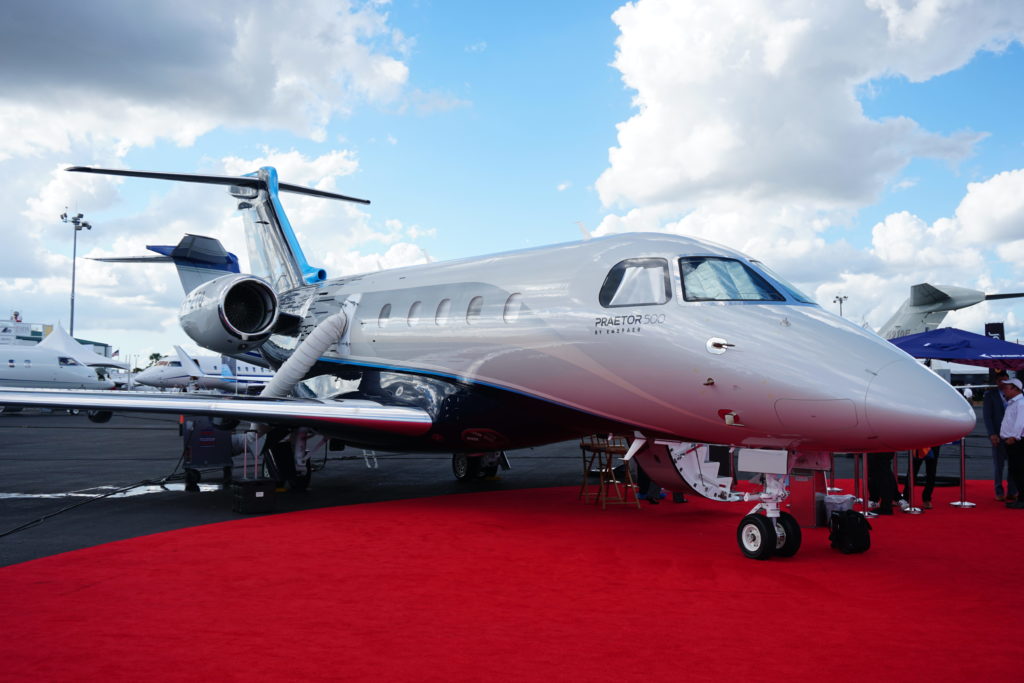
Despite a number of noticeably empty booths on the show floor at the Orange County Convention Center, as well as a seeming shortage of big announcements, NBAA-BACE 2018 nevertheless attracted close to 25,000 business aviation professionals from across the globe.
A total of 1,000 exhibitors showcased the latest products and innovations for the sector on the show floor, while more than 100 aircraft crowded the ramp at the Orlando Executive Airport and presided over the indoor static display at the convention centre.
On the eve of the show came perhaps the biggest announcement: Embraer Executive Jets launched its Praetor 500 midsize and Praetor 600 super-midsize jets at the Executive Airport, where both aircraft were on static display.
Rather than being new designs, the Praetor 500 and 600 are based on Embraer’s existing Legacy 450 and 500 aircraft, respectively.
The manufacturer has made a few key improvements, including the addition of a new aerodynamic winglet and extra fuel tanks for greater range. Both aircraft will be powered by a pair of Honeywell HTF7500E engines.
An elegant “Bossa Nova” interior inspired by the beaches of Brazil and the latest in cockpit technology courtesy of Rockwell Collins’ Pro Line Fusion package complete the renaissance.
Calling the pair of Praetors “the disruptive aircraft for the entrepreneur, for the pioneer, for the innovator,” Embraer Executive Jets president and CEO, Michael Amalfitano, said the aircraft will redefine their categories.
“The introduction of these aircraft supports our vision of fascinating our customers and providing them with superior value and the best experience in the industry,” he said at the launch on Oct. 14.
With four passengers and NBAA IFR reserves, the Praetor 600 will have an intercontinental range of 3,900 nautical miles (7,223 kilometres) and the Praetor 500 will achieve a continental range of 3,250 nautical miles (6,019 kilometres).
The fully fly-by-wire Praetor jets are currently under development, with two Praetor 600 prototypes in flight testing as well as one production-conforming aircraft, and one production-conforming Praetor 500 in its maturity campaign.
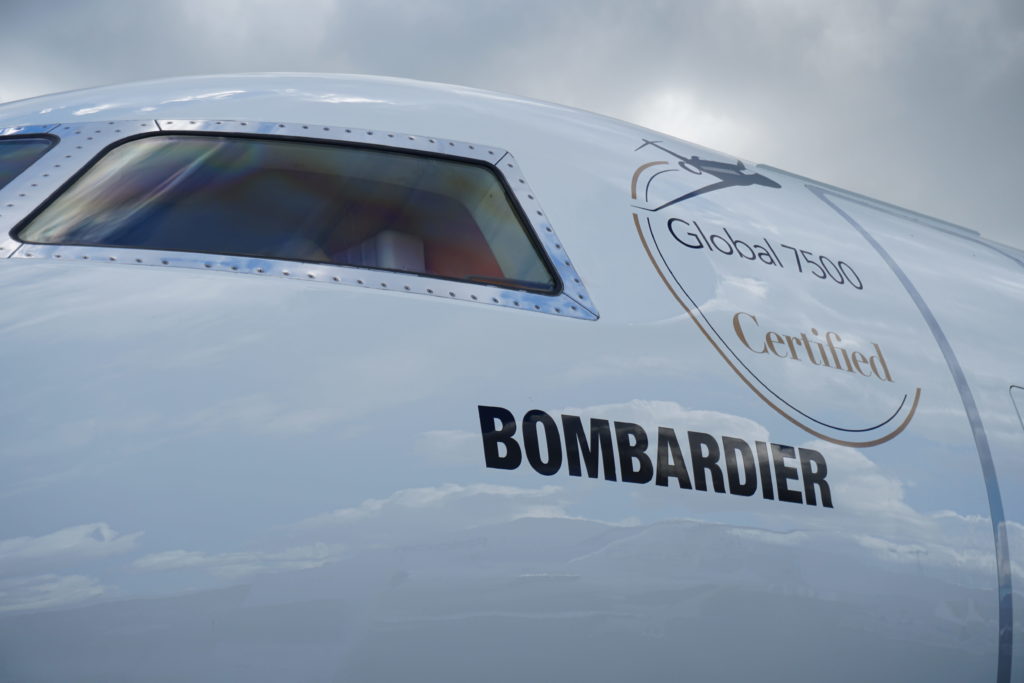
The Praetor 600 is expected to achieve certification and enter service in the second quarter of 2019, followed by the Praetor 500 in the third quarter of 2019.
Besides Embraer, other original equipment manufacturers (OEMs) reported making significant headway with program development.
Bombardier Business Aircraft delivered updates on its key aircraft programs, most notably the Global 7500 long-range business jet, which received Transport Canada type certification on Sept. 28, 2018.
David Coleal, president of the business aircraft division, said certification from both the U.S. Federal Aviation Administration and the European Aviation Safety Agency are expected imminently.
The Global 7500 is in full production in both Toronto and Montreal, with completions now underway in the first customer aircraft. Entry into service (EIS) is expected later this year.
Paul Sislian, Bombardier’s chief operating officer, provided an update on the Global 5500 and Global 6500 aircraft programs.
He said the aircraft are set apart by new purpose-built Rolls-Royce Pearl engines, cutting edge interior and avionics features, and a newly optimized wing with a re-profiled trailing edge.
Seventy per cent of the Global 5500/6500 flight test program is complete, with EIS on track for the end of 2019. First revealed at the European Business Aviation Convention & Exhibition (EBACE) in May 2018, the two new long-range jets are currently under development at Bombardier’s testing facility in Wichita, Kan.
Interior completions of the first customer aircraft are scheduled to begin later this year. The jets will feature the patented Nuage seat, as well as the reconfigurable Nuage chaise in the conference suite. With a 4K entertainment system and ultra-fast connectivity in the cabin, Bombardier is promising passengers unmatched productivity and comfort.
In the cockpit, the Global 5500/6500 will debut the first combined vision system (CVS) in business aviation. Now being developed by Rockwell Collins, the new system promises to seamlessly merge enhanced and synthetic images into a single view.
When asked about how Embraer’s Praetor will impact Bombardier’s Challenger 350 in the super-midsize segment, Coleal said he’s confident the Canadian jet will successfully compete. He called the Challenger 350 a “category-killing aircraft” and added that imitation is the sincerest form of flattery during an Oct. 15 press conference at the show.
Another aircraft unveiled at EBACE 2018 and subsequently displayed at NBAA-BACE was Honda Aircraft Company’s HondaJet Elite. Parked in front of the company’s chalet at the Orlando Executive Airport, the Elite model boasts several upgrades, including extended range through aerodynamic improvements, a quieter cabin, and an augmented Garmin G3000 flight deck with faster displays and complete performance planning for all phases of flight.
During a press conference at NBAA-BACE, Honda Aircraft president and CEO Michimasa Fujino told the press the market has responded positively to the Elite model, with the first aircraft delivered on Aug. 3, 2018.
“We are looking to bring new value to business aviation,” said Fujino, adding that there are 92 HondaJets in operation today.
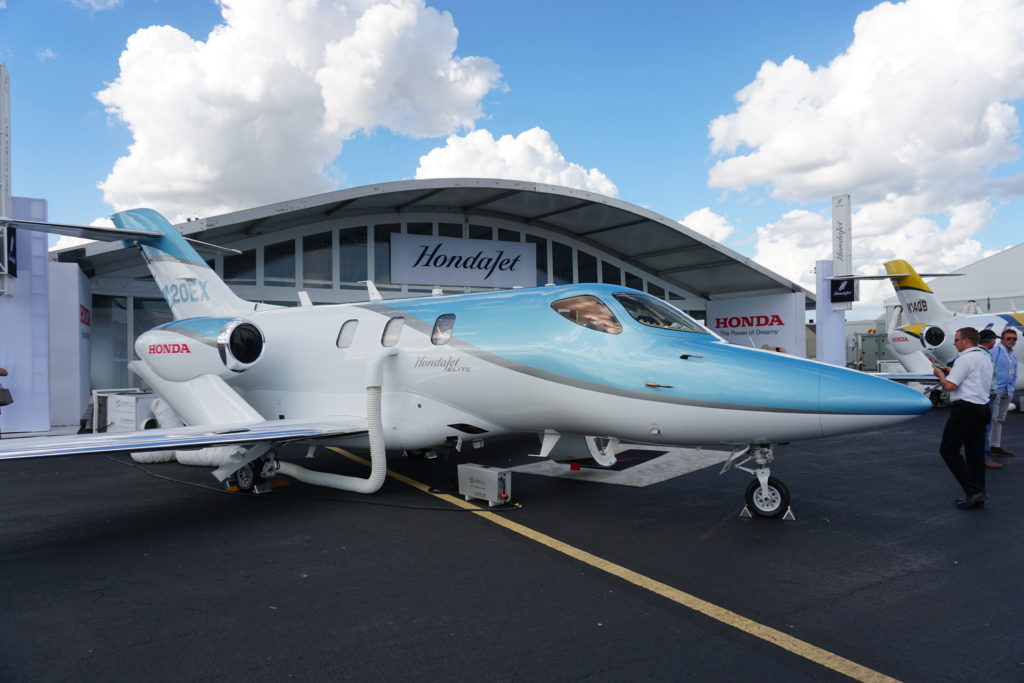
The global fleet has flown more than 20,000 flight hours and has performed with a 99.7 per cent dispatch reliability rate. The aircraft was the most-delivered jet in its category in 2017 and in the first half of 2018 as well.
At the show, Honda Aircraft announced it would be offering a performance upgrade package for the original HondaJet HA-420. Engineered by the OEM’s new Advanced Performance Modification Group (APMG), the suite of upgrades allows owners of the original HondaJet to take advantage of the latest performance and software improvements.
“As Honda Aircraft Company continues to pioneer new technologies in aviation, the APMG was created to ensure that all HondaJet owners, current and future, would have the opportunity to experience newly created, state-of-the-art technologies, regardless of when they purchased their aircraft,” said Fujino.
Moving away from jets for a moment, Textron Aviation brought a full-scale mockup of its new Cessna SkyCourier to NBAA’s flagship show.
The twin-engine, high-wing utility turboprop — which will compete with Viking Air’s Series 400 Twin Otter — is targeted at the freight, commuter and special mission markets.
The aircraft seats up to 19 passengers, although a freighter variant will also be available. Powered by two Pratt & Whitney Canada PT6A-65SC engines with the Garmin G1000 NXi avionics package in the cockpit, the SkyCourier will reportedly deliver a maximum cruise speed of up to 200 KTAS and a maximum range of 900 nautical miles.
With wind tunnel testing complete, Textron is now focused on the initial build of the aircraft’s main landing gear and nose gear. Entry into service is expected in 2020.
The Wichita-based company also displayed a mockup of the single-engine Cessna Denali, an up-and-coming competitor to the popular Pilatus PC-12NG.
With the first flight expected next year, development is progressing on schedule as GE Aviation reportedly makes good progress on the Denali’s new “Catalyst” advanced turboprop engine.
Also at the show, it was announced that NetJets will become the launch customer for the Cessna Citation Hemisphere aircraft. On Oct. 15, Textron and NetJets revealed that the fractional company has signed fleet agreements for the option to purchase up to 175 super-midsize Cessna Citation Longitude aircraft and up to 150 Cessna Citation Hemispheres.
Finally, Textron’s training arm, TRU Simulation + Training, plans to enter a joint venture with FlightSafety International to provide a full range of training services for Textron’s broad range of aircraft. TRU–which has roots in the former Mechtronix Inc. of Montreal–will be the exclusive supplier of simulators to the joint venture.
Also at NBAA-BACE 2018, Gulfstream reported a second range increase for its all-new G600 business jet.
The aircraft will now deliver 5,500 nautical miles (10,186 kilometres) of range at its high-speed crise of Mach 0.90, a 700-nm (1,296-km) increase over original projections. That means the aircraft can fly non-stop city pairs such as London to Los Angeles or São Paulo to Aspen.
The G600 is nearing the end of its flight test and certification program, reported Gulfstream, with only crew workload, flight into known icing, and function and reliability tests remaining.
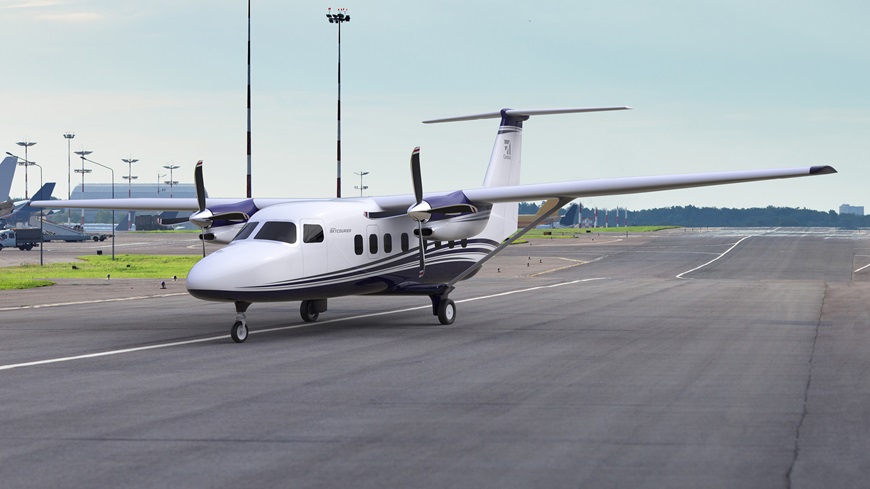
Its sister aircraft, the all-new Gulfstream G500, has already achieved U.S. certification, with EASA approval expected shortly.
Meanwhile, the ultra-long range G650 was in the midst of obtaining approval to operate at London City Airport, where a steep 5.5-degree approach and short 4,327-foot runway necessitate additional steep-approach certification and operational validation.
Other news from the Savannah-Ga.-based OEM included approval from the U.S. Federal Aviation Administration (FAA) for Visual Advantage credit, using the enhanced flight vision system (EFVS). An industry first, this approval allows specific operators to begin instrument approaches in conditions below published minima.
Gulfstream is expecting final FAA certification and operational EFVS approvals for the G500 and G600 by the end of this year, with approvals for the G450, G550 and G650 to follow.
Pratt & Whitney Canada (P&WC) hosted a media luncheon during NBAA-BACE 2018, where leaders provided an update on company activities.
Maria Della Posta, the company’s senior vice-president, said the engine manufacturer is always looking ahead to identify future customer needs. She said the company remains relevant by looking after its current customers, continuing to invest in new products and services, and bringing innovative solutions to customers around the globe.
“We’re excited about the growth opportunities coming from many of the trends that are out there,” said Della Posta. “Economically, we see a lot of indicators going in the right direction, which is driving growth in both new and pre-owned aircraft. We also see a lot of new channels, in terms of how to serve customers better.”
The increasing prevalence of online shopping and the resulting growth in courier services presents opportunities for P&WC, she added. A good example is Textron’s selection of the PT6A engine for its new Cessna SkyCourier aircraft.
“We’re very optimistic about growth prospects and our ability to continue to play a leadership role in every one of spaces,” she said.
Cedric Gauthier, P&WC director of sales and marketing, Business Aviation, said the past month has been very exciting.
“We had the entry into service of the PW814GA on the Gulfstream G500, and that’s a culmination of many years of hard work by our teams … The 814 will soon be joined by its big brother, the PW815GA, on the Gulfstream G600 once it enters service. We are very pleased as well that the PW812D was selected earlier this year by Dassault to power the new Falcon 6X.”
P&WC offers 38 engine models for the business aviation segment, with more than 18,450 engines produced for over 5,500 operators.
Other Canadian exhibitors at NBAA-BACE 2018 included Innotech-Execaire, which was honoured by Textron Aviation with a plaque commemorating its 25 years as Canada’s exclusive authorized sales representative (ASR) for Cessna Citation jets.
In addition to being an ASR, the company has been a Cessna authorized service facility (ASF) for more than 40 years.
The 25-year anniversary was recognized on Oct. 16, 2018, at Textron’s static display at NBAA-BACE, where a plaque was presented by Steve Sperley, vice-president of sales, Textron Aviation, to Ray Kuliavas, vice-president of sales, Innotech-Execaire.
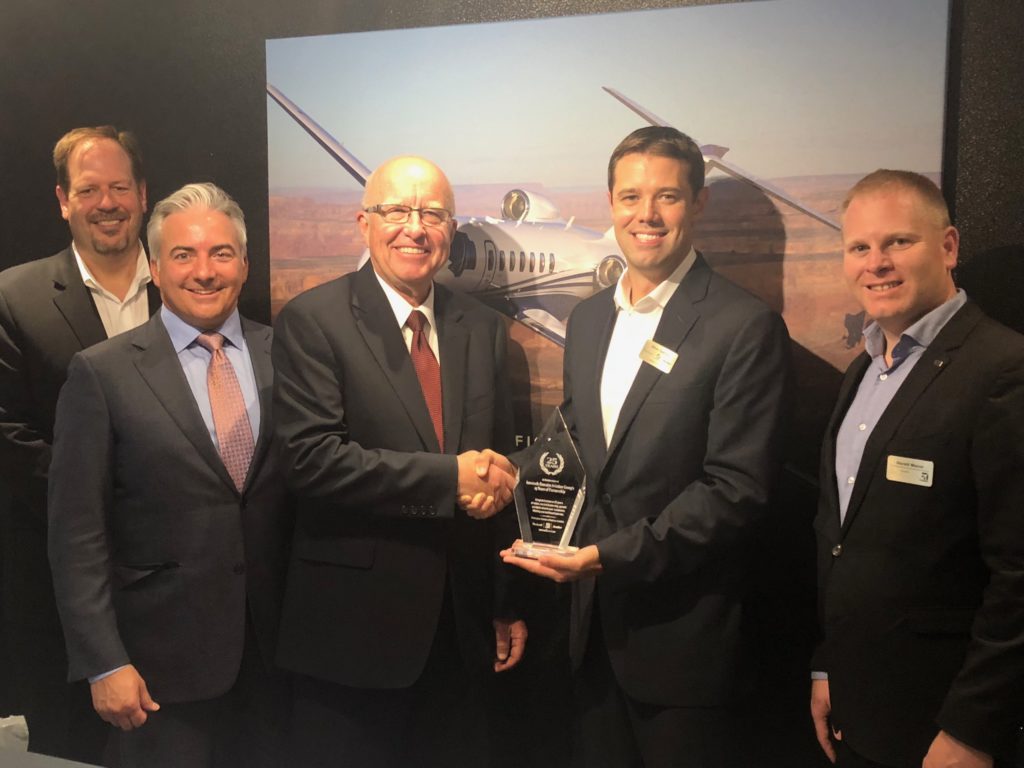
“We are obviously thankful for Textron’s recognition of our 25 years of service, and equally proud of our achievements,” Kuliavas told Skies.
“It has been an honour–and quite frankly a lot of fun–representing Cessna and promoting Citation Team Canada. None of this would have been possible without the trust and loyalty of our customer family.”
Another Canadian company, Flying Colours of Peterborough, Ont., was also excited about what vice-president Sean Gillespie called its “big expansion.”
“We’ve been doing slow expansions for the last three years, but this is the biggest one,” he said. “It will be about 100,000 square feet, a combination of a new paint facility as well as a new completions and maintenance facility, as well as offices and design centres.
“It will basically be replicating what we already have. As Bombardier’s preferred completions centre, that business is building up. So the goal is to have a completions centre and an MRO centre and sustain both.”
The family-owned company’s St. Louis, Mo., branch has also been growing. A new 30,000-square-foot building has been leased for December and will be capable of accommodating up to three Bombardier Global aircraft, which that location has never been able to process before.
“It gives us a lot more footprint,” Gillespie told Skies on the trade show floor.
Kevin Kliethermes, Flying Colours’ director of sales in St. Louis, said customers are interested in a range of services, from completions to partial and full refurbishments, to major heavy maintenance checks. Most of their work is done on midsize business jets and larger.
Connectivity, he said, continues to top the to-do list.
“Everyone is trying to replicate the home environment. They want to walk on with their phone, and have the ability to stream or do whatever they want to do on board.”
The Bombardier Global airframe remains the company’s focus for the foreseeable future, with other business built around that capability. For example, the company is currently designing a couple of Global 7500s with non-four-zone interiors.
Finally, Gillespie said Flying Colours is also working to expand its share of missionized modifications. The company is involved with Saab’s GlobalEye airborne early warning and control and Swordfish maritime patrol aircraft, which involve missionized interiors built upon the Bombardier Global 6000 platform.
Canadian simulation powerhouse CAE released its 2018 Airline and Business Jet Pilot Demand Outlook at the show.
According to the report, the active business jet pilot population will reach 65,000 by 2028, which represents an increase of 18 per cent, with a turnover rate of almost 100 per cent.
That means 10,000 new business jet pilots will be required to sustain growth and 40,000 new business jet pilots will be needed to support retirement attrition across the segment over the next decade.
“Today’s soaring pilot demand is a reality that we must all face. As the leading training organization in the world, we are honoured to offer our partners the training solutions they need to face this rising demand,” said Marc Parent, CAE’s president and CEO.
The free report can be downloaded here.
CAE also announced it has added a new Bombardier Challenger 604 simulator to its training centre in Dallas, Texas.
Everywhere at the show, the outlook was positive.
“The convention showed that this is one of the best environments for business aviation in decades,” said Ed Bolen, NBAA president and CEO. “We focused on the people, technologies and leadership qualities that will maximize today’s opportunities, while keeping an eye on the investment and innovation that will drive the industry’s future.”
Next year’s NBAA-BACE will return to Las Vegas, Nev., from Oct. 22 to 24, 2019.








